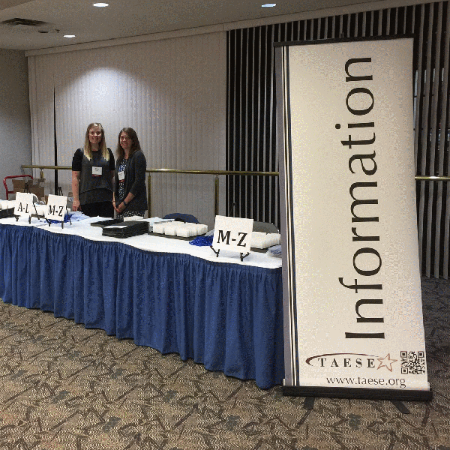Planning An Accessible Event: Tips From TAESE

When you often host more than one event a week, you know a thing or two about conference planning. The Center for Technical Assistance for Excellence in Special Education (TAESE) at the Center for Persons with Disabilities manages training events and conferences all over the United States. In addition to numerous gatherings of 100 or less, the TAESE team hosts seven large events of more than 100 participants every year.
That number is likely to grow, as TAESE was just awarded two more contracts that include webinars, meetings and onsite conferences. Indeed, their event-running savvy has been sought after by education organizations nationwide.
So when we asked Conference Coordinator Alyssa Henke and Program Coordinator Brenda Smith for some tips on running an accessible event, they drew from a deep well of experience. This is what they said.
Planning The Presentations
TAESE planners ask their presenters to provide accessible materials. Often these are offered electronically, and it can be tricky. An accessible document has to be intentionally created; it doesn’t happen by accident.
“A lot of presenters are getting their materials together at the last minute,” Smith said. They may not know how to create accessible PowerPoints or PDF documents. “This is something that we do often, but we’re asking a presenter that’s never made it accessible to do that.”
Resources from WebAIM can walk presenters through the process. (WebAIM is also part of the Center for Persons with Disabilities at Utah State University.)
Registration
During registration, TAESE asks if participants need accommodations or if they have dietary restrictions.
Two of the most common accommodations are the need for sign language interpreters or large print materials, Henke said. She’s careful not only to provide what is needed. She also makes sure that if interpreters are needed, space is designated for them while they’re interpreting.
Also, Smith and Henke said, don’t forget to provide a meal for the interpreters. Ask them if they have dietary needs (if they are not conference registrants, you will need to get this information from them another way). And don’t forget to provide meals for your own staff—they won’t show up on the registration count.
Getting Into The Event
It helps to know how participants are arriving at the event, Henke said. Are they flying or driving in? If they’re flying and use a wheelchair, do they have an accessible way to get from the airport to the hotel, and the hotel to the conference location?
If they use a wheelchair and they’re staying in a hotel, is it accessible to them? Can they use the bed or get into their bathroom? “If they can’t, it makes it hard to be an engaged participant,” Smith said. “It affects the quality of the meeting.”
Smith and Henke agreed that good communication solves a lot of problems. The definition of an “accessible” hotel room varies a lot, so it’s good to be specific about the needs of the conference-goer: for example, that the beds are at a workable height and bathrooms are fully accessible to wheelchairs.
Then there’s parking. Smith said TAESE has held events in downtown locations with limited parking, including accessible parking spots. They have even been in locations with very tight security, where all participants must go through a security screening and are then escorted to the meeting by a staff member.
All of these issues are solvable, but they take time, Smith said, so ask a lot of questions. If you need extra time to check in your participants, build it into the schedule.
Doing A Pre-event Walk-through
Usually the building meets ADA requirements and building codes, but it’s still important to watch for issues. Henke likes to check the venue well ahead of starting time. Are the tables and chairs spaced wide enough apart that a wheelchair can get through? Does the podium have a ramp so that, if people in the audience are asked to come up, those who use wheelchairs can participate?
It could be the catering supervisor knew a participant had a violent allergy to strawberries, but the information didn’t trickle down to the kitchen staff. It’s good to catch those errors before the guests are at the table.
Henke recommended doing a sound check as well, to make sure presenters can be heard.
“I think hotels want to help and be accommodating,” she said. “Most venues are really good to work with.”
Be Available During The Event
No matter how clear you are in your directions during registration, no matter how much you plan, you will still need to be flexible and solve problems as they come. “Conference planning is like that,” Smith said.
She recommends not only being present, but walking around and being observant.
Maybe it snows the day of the event, and participants with wheelchairs or walkers now face a plowed-snow barrier on their way to the building’s entrance. Maybe the participant who isn’t eating lunch really is hungry—he just doesn’t know how to find his gluten-free meal. A nursing mother may need a private room.
There’s good news, too, Smith said. “Conference center staff are generally a text away.”
Evaluations
Henke and Smith agreed: No matter how closely you watch the event, you’ll never know everything about how it went. That’s why it’s so important to provide an evaluation process for participants so that adjustments can be made for the next time.

